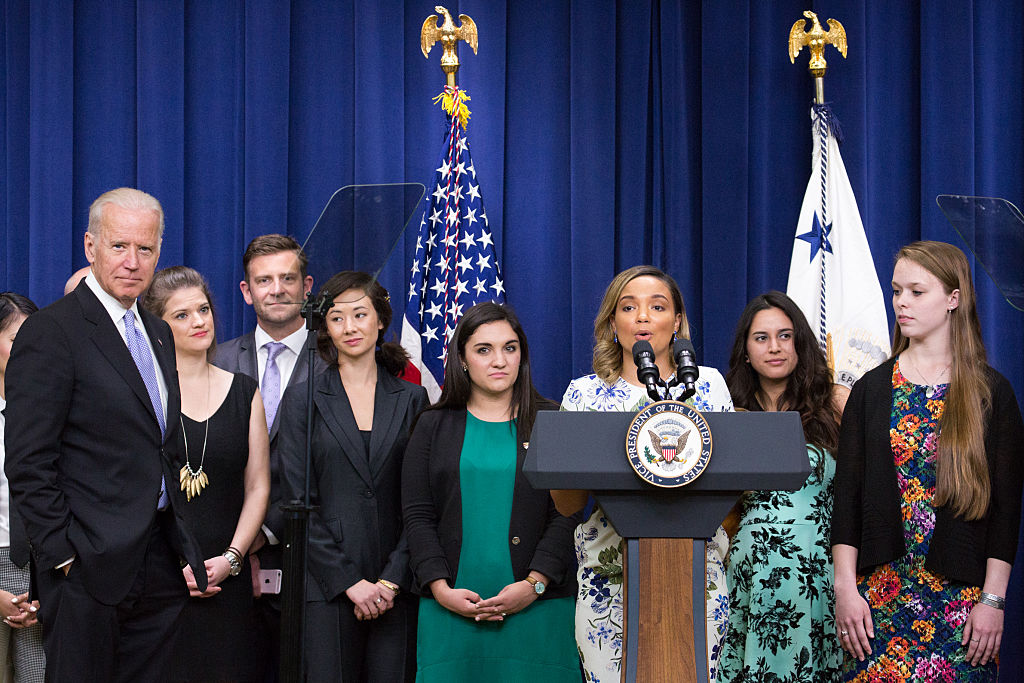Opinions about Title IX differ greatly along gender and party lines, especially in regards to the impact of Title IX on sports.

“No person in the United States shall, on the basis of sex, be excluded from participation in, be denied the benefits of, or be subjected to discrimination under any education program or activity receiving federal financial assistance.”
—Title IX of the Education Amendments of 1972
This year marks the 50th anniversary of those few words that have drastically changed the landscape for girls’ and women’s educational opportunities over the last half century.
Title IX flatly prohibits institutions that receive federal funding from practicing gender discrimination in educational programs or activities. Because almost all schools receive federal funds, the law applies in nearly every educational context.
Even though it covers all educational programs, most people associate Title IX with athletics, where it has indeed had a profound effect on girls and women. Before Title IX, women and girls were virtually excluded from most athletic opportunities in schools. Just 7 percent of all high school athletes were girls, and females received a paltry two percent of school athletic budgets. Athletic scholarships for women were simply nonexistent.
There’s no question the law changed school athletic programs and practices, but did it change people’s minds about gender and equal opportunities in sports? To find out, The Pew Research Center in Washington, D.C. did a national survey to gauge awareness and attitudes about Title IX 50 years after its passage.
While much of the survey is encouraging, it also shows there is still a ways to go when it comes to full public support of equal athletic opportunities for women and girls. For starters, many are just not paying attention. Of the original sample of 9,388 people chosen for polling, only 50 percent had “heard of or read” about Title IX (37 percent said “a little” and only 13 percent said “a lot”).
Women over age 50 were more likely to have heard of the law than younger women. (It’s a sure bet that a large number of those over-50 women had been barred from school sports before the law was passed.)
In a nutshell, among those who know about Title IX, there are both gender and political gaps in how they think about it. Racial or ethnic information was not included in the survey.
- Half of the men said athletic funding should be equal across genders, but the number of men saying funding should be based on the amount of money generated was twice of women (30 percent vs. 14 percent respectively).
- Women were much more likely (71 percent) than men (50 percent) to say college sports should be equally funded regardless of gender.
- Women (39 percent) are also more likely than men (31 percent) to say there’s not enough emphasis on girls participating in youth sports. It’s no big surprise that women are also much more likely (42 percent) than men (29 percent) to say too much emphasis is placed on boy’s participation.
- There are significant partisan gaps when it comes to participation, with Democrats much more likely than Republicans to say there is too much emphasis on boys (45 percent vs. 25 percent). The same is true when it comes to too little emphasis on girls (44 percent Dem., 26 percent Rep.).
- Democratic women are especially likely to say Title IX has not gone far enough: 60 percent, compared with 42 percent of Democratic men. Only 27 percent of Republican women agree, while a paltry 13 percent of their male counterparts say the law needs to go further.
Since men are undoubtedly still the majority when it comes to keeping up with sports in general, it’s discouraging that nearly a third of them say equal treatment should be contingent on “the amount of money brought in by a team.” School sports are supposed to be about opportunity, not money. Disregarding the impropriety of using the almighty dollar as a yardstick for value to begin with, male sports had a 100+ year head start in developing fans and producing revenue. It’s grossly unfair to expect females to catch up instantly.
As in most fights for gender equality, the job is not yet done. But there’s still cause for celebration of the successes and positive attitudes about Title IX 50 years in. Without it, boys and men would still own sports, and girls and women would still be relegated to cheering them on with pom-poms and pretty smiles from the sidelines.
Up next:





